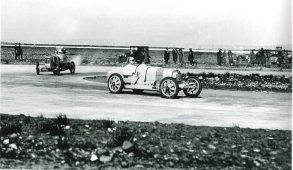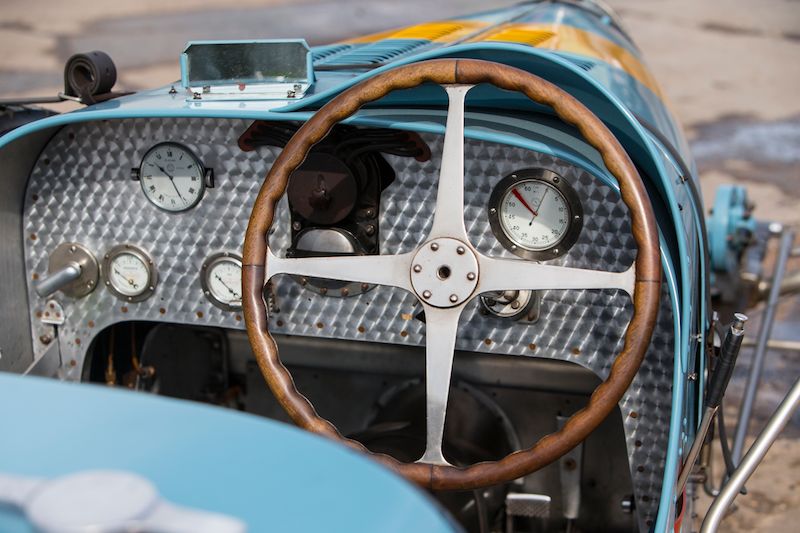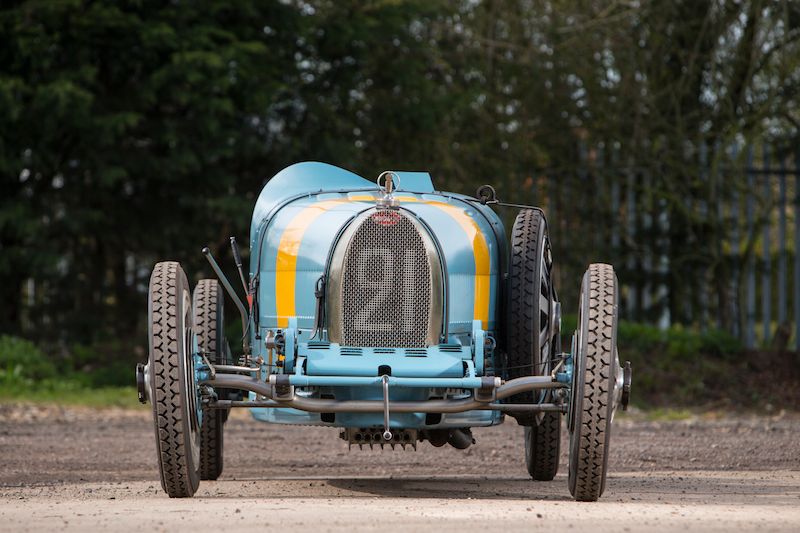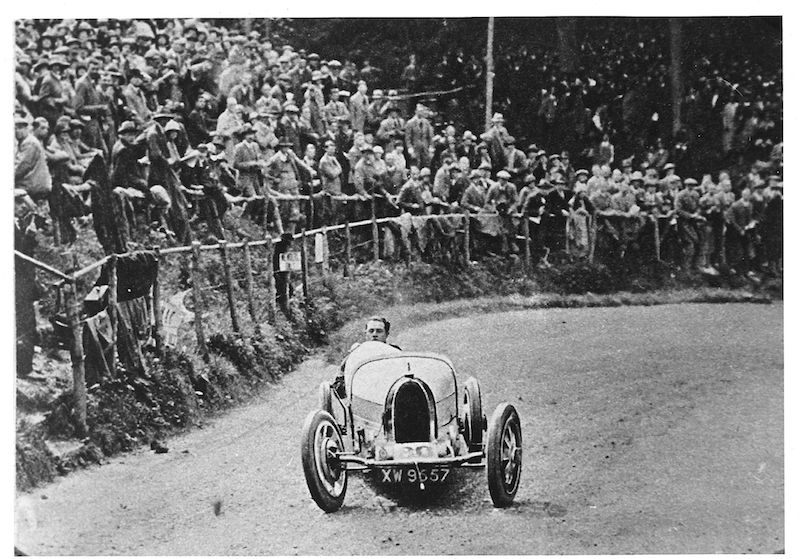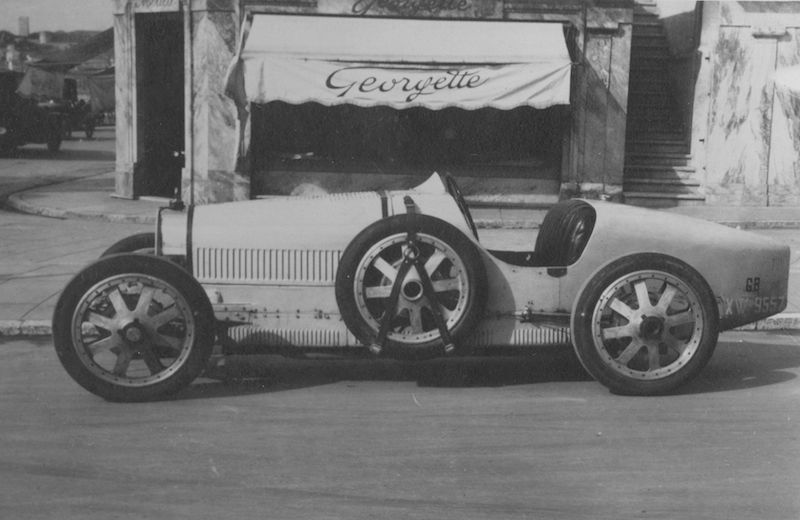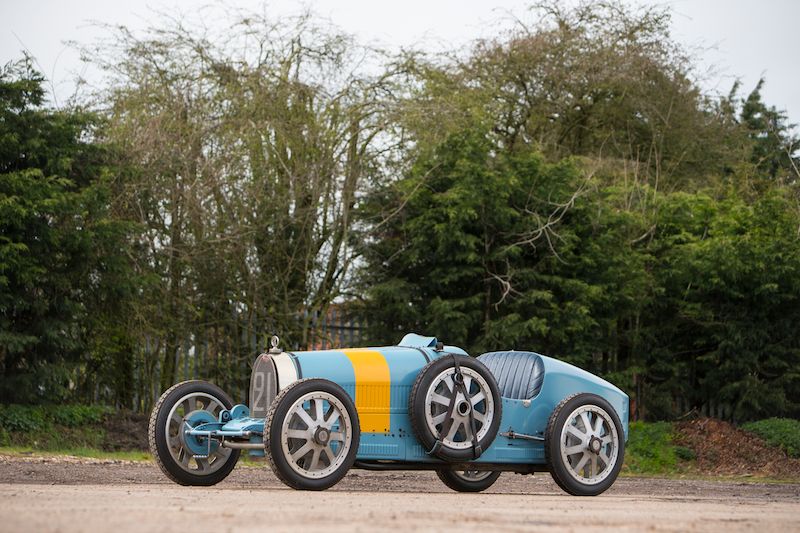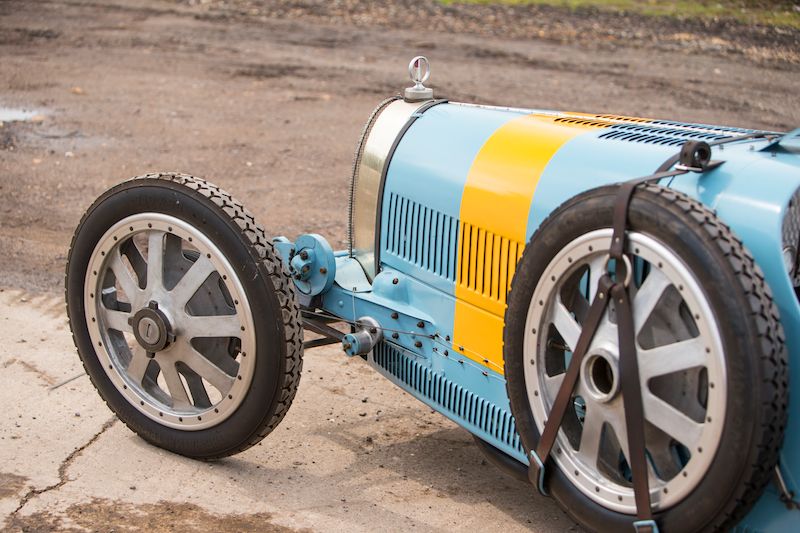Some of the world’s most evocative Grand Prix cars are those originally manufactured during the 1920s, not necessarily for racing team use but primarily for sale to private customers, providing them with the equipment necessary to take the plunge – and to go motor racing upon their own account potentially at the very highest level.
Of course it was the marque Bugatti from Molsheim, Alsace, which most prominently provided that service, and most notably with its magnificent family of compact, light and powerful straight-8 engined Bugatti Type 35s. This much loved, neat and nimble design was introduced at the Grand Prix de l’ACF in 1924, and manufactured in a series of subsequent variants for customer sale.
Bugatti Type 35 chassis No ‘4450’ here was the nineteenth such Grand Prix Bugatti to be manufactured, as reflected by its chassis frame number ’19’. The order for the car was numbered ’21’. Its construction was completed in January 1925 and it was entered into the factory production book with the annotation: “o.d.f. (ordre de fabrication) 10.1.25”. These early cars are known as the ‘Type Lyon’ and they differed in detail from later Type 35s. As delivered, they lacked a rear-view mirror and an engine driven air pump for the fuel tank. Since a riding mechanic was still mandatory for Grand Prix racing, his duties included maintaining fuel pressure while also acting as the driver’s lookout to spot any imminent overtake from behind. On the dashboard the gauges, including the revolution counter, were mounted with screws through the front of the bezels.
The new car was delivered new via Jarrott & Letts (London) Limited to former Brescia Bugatti owner Lieutenant Glen Kidston, RN. It seems that he collected it from the Molsheim factory, where it had been French-registered on February 14, 1925, with the temporary number ‘1768WW5’. This was granted for ten days only, which enabled Glen Kidston to drive his new acquisition home to London, where the car was UK road registered ‘XW9557’. Lt Kidston promptly returned to France with the car and drove it down to Marseilles where he achieved a fifth-place finish in the 1925 Grand Prix de Provence at Miramas Autodrome, also finishing second overall in the 2-litre class, sandwiched between the sister Bugattis of class winner Vidal and third placeman Cozette.
Photographs taken on Lt Kidston’s journey south show that the car, like preceding Type 35s, lacked retaining clips for the forward bonnet strap. This omission allowed the strap to slide forwards onto the radiator. While in Provence the car was garaged at Ernest Friderich’s celebrated Bugatti dealership in Nice. While there, front bonnet-strap clips were added, together with bonnet-lifting handles. The clips used were actually Brescia electrical wiring clips which remain on the car to this day. The bonnet lifts serve to identify the car in early photographs. In accordance with the regulations, the bonnet had a yellow band painted on it to identify it as belonging to the GP de Provence 2-litre class. The car proudly wears a similar band today.
At Easter 1925, Lt Kidston ran the car at Brooklands. His was the second GP Bugatti to appear in England and the first Bugatti Type 35 to compete at the legendary Weybridge Motor Course. In consequence it attracted considerable interest. In the Private Competitors’ Handicap race Lt Kidston finished third with a fastest lap of 103.97mph and later that day won the 90mph Short Handicap race after lapping at 104.63mph.
The Whitsun Brooklands Meeting saw the dashing and bold Naval officer unplaced in one race despite lapping the bumpy Outer Circuit bankings at 109.46mph but in the Hundred Miles per Hour Short Handicap race he finished second, lapping at 110.68. An account of Kidston’s driving explains that he “…was in his first season of motor sport, and tended to favour win-or-bust tactics”. In a lurid but undeniably spectacular ascent of Shelsley Walsh hillclimb, Glen Kidston’s “…lovely blue Bugatti clouted the bank by the Kennel Bend and then went into an almost broadside skid on the first corner of the Esses, showering grit and loose stones over spectators in the members’ enclosure….”.
Following further race appearances at Brooklands in June and August 1925, Lt Kidston’s short and spectacular racing career was put on pause as he announced his engagement to “the bewitchingly beautiful”‘ Nancy Soames, undertaking to give up motor racing. Or, as ‘Motor Sport’ put it, the gallant officer “…sacrificed his Bugatti before the altar of Hymen”. This undertaking lasted until 1929 when he re-entered the sphere, this time as a successful Bentley works team driver.
Meanwhile, George Duller, equally successful as racing driver and horse racing jockey, took over ‘4450’, achieving a fastest lap of 111.17 mph during the Autumn Brooklands meeting in mid-September. In the subsequent ‘Summer 1927 Sporting Life 100 Mile Handicap’, Duller both finished second and set a new Brooklands Class E 100-mile record at an average of 109.52mph from a standing start; impressive for a 2½-year-old 2 litre car.
By that time, the car had been fitted with black-painted wire wheels, small brake drums and hefty knock-on hub nuts – all of which were still on the car when purchased by the current vendor. One suspects that the reason why many GP Bugattis raced at Brooklands had their standard cast-aluminium wheels replaced by more conventional wire wheels is that the cast-type were cracking due to the high-speed pounding meted out by the frost-heaved, much-patched and bumpy concrete of the Outer Circuit.
1925 Bugatti Type 35 Grand Prix – Profile Page Two
The car subsequently disappeared from the public eye through 1928 before its reappearance at Brooklands in 1929, driven by new owner Vivian Selby – a cheerfully amateur racing enthusiast who would in the 1950s become team manager of the Bristol Aeroplane Company’s long-distance sports car team, campaigning its wonderfully aerodyne 450 model Coupes and roadsters. It would appear that in its initial Brooklands outings with Selby the car was not at all au point, for its new owner retired it from his first race that day in the 90 Short Handicap, then lapping at a meager 88.15mph in the 90 Long Handicap.
During the subsequent 1930 March Brooklands Meeting the car lapped again at 81.91mph but despite lapping at a much more respectable 100.82mph in the later Long Handicap it remained unplaced.. Selby subsequently achieved a couple of third places with ‘4450’ in minor Brooklands races and lapped on two occasions at 100.01mph.
His 1931 season with the car began well at the Weybridge track as he took two first places in the March Meeting there and a first and second at Easter. In the Easter Meeting’s Lightning Short race he wound up the car – and perhaps himself – to record a 109.2mph lap of the Outer Circuit…at last back upon Glen Kidston pace…
In his ownership the Bugatti was painted blue with black wheels, and away from Brooklands Vivian Selby achieved rather more significant success with it racing on the sandy tide-washed beach at Southport in Lancashire. As many as 50,000 spectators would line the sand dunes backing the strand there to watch racing in 1930 when they saw Selby win in the Bugatti now offered here by fully two minutes from ‘Scrap’ Thistlethwayte’s gigantic Mercedes-Benz.
On Southport Sands in 1931 Selby finished second to Jack Bartlett’s Grand Prix Salmson in the Southport One Hundred Miles. Tom O’Hara was the mechanic who cared for ‘4450’, during part of Vivian Selby’s lengthy ownership. Forty years later Tom O’Hara recalled:
“In 1935 I was employed by the H.W. Papworth Stable at Filmer Road, Fulham, as mechanic for the season. At that time there were a number of cars under roof and the stable had a good name together with more than its fair share of race successes…
“The Vivian Selby two-litre lay in a corner of the shop rather neglected until Selby decided to run in the 50-mile race at Birkdale, the Southport Motor Club’s first meeting of the season. Selby and the Type 35 had won every race, 25 – 50 – 75 – 100 miles the previous season. With a minimum of preparation and against advice the car was loaded on the transport and driven to Southport. Vivian met me at the hotel about midnight and a meeting was arranged for 5.00am at the circuit.
“The car was warmed up and after usual checks and a change to hard plugs, away went Selby for a few practice laps. Running very well and more than satisfied with the practice, he came in satisfied that we should bring home the gold later in the day.
“About 8.00am the Club Secretary turned up and Selby said to him, ‘Come along and try out the course’, and off they went for a couple of laps. The comments on return were “that the sand was drying the south bend was a bit loose’ and so we all went to breakfast.
“Back to the course to carry out my pre-race checks, a clean set of plugs and then the off. All went well for about thirty miles and a slow car limped in, the motor had more than over-revved in the loose sand, an exhaust valve dropped to be punched through the cylinder block and out through the exhaust manifold, so it was back to Fulham for repairs.
“I prepared in more than a hurry for the second meeting of the season and as a result of inadequate repairs, the car again did not finish. After repairing the motor a second time we went to Brooklands for more extensive trials and tuning, the car was got into fair condition and raced at a weekend meeting.
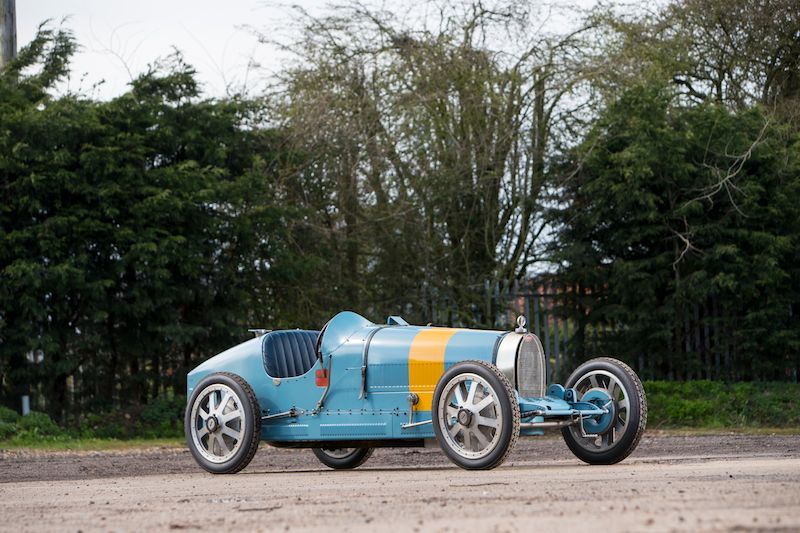
“As with most cars at that time having been timed at or near best speed, a good run was not enough and the handicapper always won.
“The car raced again that season, Selby having loaned it to a friend, it ran well but with no success, if I remember rightly, lapping about 104 to 106mph. I left the Papworth Stage not so long after, and it was the last I heard of the car for some time
“In 1937 after the International Trophy at Brooklands we went along to ‘The Ship’ at Weybridge for a bit of a party and whilst the race of the day was again being won or lost through a haze of Best Bitter, who should show up but Vivian Selby. His first words to me were ‘And what crowd are you with now?’ This led to me asking ‘What are you running?’. He said ‘Nothing, can’t compete with blokes with ERAs, Maseratis and things like that; above my class. I have sold the Type 35 to a bloke in South Africa. It should give them some fun out there…'”.
In fact Vivian Selby’s buyer for the Bugatti would appear instead to have been from Australia, a teenaged enthusiast named Lyndon Duckett. He was in England seeking a twin-cam Grand Prix Bugatti, and he had found ‘4450’ standing at Papworth’s with its engine removed and standing separately alongside. He returned to Papworth’s after an abortive trip to the Bugatti factory at Molsheim, Alsace – seeking a twin-cam engine he had been advised they had one available, only to find upon arrival that they could offer only a single-cam unit, which he declined. Back in London he finally bought this Type 35’s chassis into which he intended to install a new Anzani R1 engine acquired from the manufacturer’s factory at Kingston-upon-Thames, just to the south-west of central London. The Bugatti engine was left behind at Papworth’s and would subsequently find a home in Kenneth Eckersley’s Bugatti Type 35 – chassis ‘4744’.
1925 Bugatti Type 35 Grand Prix – Profile Page Three
At this point Bugatti Type 35 chassis ‘4450’ was poised to provide the basis of one of Australian motor sport’s most enduring and popular great racing specials – the Anzani Bugatti – better known to more than one generation of Australian enthusiast as ‘The Anz’…
We believe that only some 12-15 Anzani R1 engines were manufactured, powering – for example – the very rare Squire sports cars. Lyndon Duckett’s unit acquired for Bugatti Type 35 chassis ‘4450’ is recorded as having been serial ‘R1-62’ which was the last such power unit to leave the Kingston factory. These engines were never fully developed by their original manufacturer, and Duckett endured some pain with it before finally re-building the unit towards the end of World War 2, after which it reportedly proved “amazingly reliable”.
Lyndon Duckett initially had the engine mated to the Bugatti chassis in England, by Pacey’s of London, but upon his return to Australia he found the work unsatisfactory and had it re-mounted in Melbourne, Victoria. He also had a new body with attractive round-tailed profile made for the car by the Cardigan Motor Body Works of Carlton, a Melbourne suburb, this was presumably due to the punitive import duty on foreign coachwork at this stage in force in Australia.
During the following ten years Lyndon Duckett used the Anzani Bugatti extensively in Australian motor sporting events. One early success was fastest time of the day in a vintage sprint held at ‘Killara’ – the extensive property owned at the time by Lex Davison and his wife Diana – on March 17, 1946.
The journal ‘Australian Motor Sport’ reported: “In the second run Lyndon Duckett seemed to be going much faster until the clutch slipped in third gear, causing the engine to over-rev, this in turn caused valve bounce, net result – four bent valves and broken valve guides…”.
During that year Mr Duckett was the inaugural winner of the Vintage Sports Car Club of Australia (Victoria)’s Vickery Trophy, its premier award, for “….total points of 24, gained over six events held during the year, (including) two quarter-mile acceleration tests, three reliability trials and one hillclimb. In those events he made fastest time of the day in each of the quarter-mile sprints and the hillclimb, and also won the Kinglake Trial run in August. ..his Anzani Bugatti was a regular and consistent performer”.
The car also set FTD in the 1½-litre racing car class at the Rob Roy Hillclimb, and FTD in quarter-mile acceleration tests at Marsden Park Airstrip in New South Wales.
Lyndon Duckett and the Anzani Bugatti subsequently became a regular star of the Rob Roy hillclimb Vintage class. He also took ‘The Anz’ to Bathurst for the Mount Panorama circuit races, but after being timed at over 90mph through a quarter-mile speed trap during practice he was unhappy with being re-handicapped (as he saw it punitively so), and withdrew.
The Anzani Bugatti was described at length in a dedicated feature story published in the ‘Australian Motor Sport’ issue of February 15, 1949. It concluded: “The appeal of the ‘Anz’ seems to lie chiefly in two things; first the fact that everything on it is strictly functional – there doesn’t seem to be one superfluous bit of equipment – and second its always immaculate appearance in every detail. The body and chassis are finished in gleaming black, relieved by the chromium plate of the axles and running gear, and inside the bonnet and cockpit everything is either polished, plated or enameled. You get the feeling you could conduct a major overhaul without rolling up the sleeves of a white shirt…”.
Eventually, in 1962, the car was sold to Richard Manton, but he – tragically – lost his life soon after, on his 21st birthday, when he crashed in an E-Type Jaguar. ‘The Anz’ then passed to a friend, Bob Lemon, of Toorak, before being acquired by the current vendor (for many years the recognized authority on Bugatti cars in the Southern Hemisphere) – for £500 – on the 18th July, 1964. He has not only retained ‘4450’ over the intervening 52 years since then, but he also raced, sprinted, hillclimbed and rallied it extensively before more recently restoring it painstakingly to its original Bugatti Type 35 engined configuration.
Writing of the car in recent years he has recalled how, on the way home after purchasing it: “…the car was found to lack brakes owing to stretched brake cables. That afternoon the cables were shortened by the simple expedient of wrapping them around a bolt and clamping them with a nut (Scrutineers were more tolerant in those days). The next day the car competed in lap dashes at Calder Raceway and was second fastest on aggregate time to Laurie Rofe’s Type 37A Bugatti…
“The writer has enjoyed numerous events in this car… It has been rallied, raced, sprinted and hillclimbed, and has not only been very successful, but has also been very reliable. In 1991 at the Geelong Speed Trials the car covered 420 yards in 16.8 seconds…”
“Few cars have had such a long and successful racing history…”.
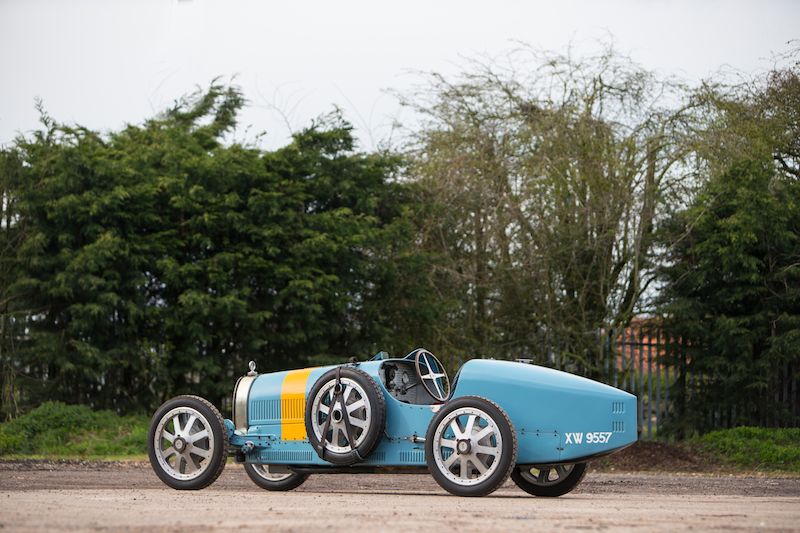
1925 Bugatti Type 35 Grand Prix – Profile Page Four
In more recent years the decision was taken to convert the car back to original Glen Kidston/George Duller specification – prompted in part by the long-term owner having accumulated much of a matching Type 35 engine. The restoration work commenced on December 29, 2006 and the complete restored and re-assembled car was re-started for the first time on January 24, 2008.
Original components retained in this process comprised the chassis, including all cross-members, dampers and all leather parts, the front end including the hollow axle, steering, steering box, steering arms etc, brakes including the shoes and front back plates, clutch pedal and clutch shaft, gearbox, gear-lever and handbrake lever, tail-shaft, back-axle, springs, dashboard structure and dashboard, radiator, top of bonnet panelling, fuel cap and manual air-pump.
Other Molsheim-made components used in the restoration include a 35C sump numbered ’75’, new old-stock water pump, water pump support, No ’28’, oil filter, base No ’75’ to match sump, cam-box and camshaft, cam-box lid, an ex-Type 30 clutch (the same as the GP type), flywheel No ‘7’, oil pump, oil galleries and pipes, step-up gearbox and much of the magneto drive and advance/retard mechanism. Further Molsheim parts used include the exhaust headers, oil breathers and water rails, various cover plates and sump accessories, crankcase, bonnet-strap sprung buckle assemblies, the front dashboard panel and ex-Type 37A instruments except for the special early-Type 35 rev counter.
New components used in the restoration comprise the body – apart from the original bonnet-top – beaded-edge Crosthwaite & Gardiner wheels and straight-sided by Rudi Kreyer of Germany – crankcase by Crosthwaite & Gardiner, and cylinder blocks by Dutton in England. Parts sourced in Australia include rotating and reciprocating engine internals. All valve-gear and the oil transfer pump was provided new from the Bugatti Owners’ Club, while the fuel tank is also new-made but incorporating original fittings.
Bugatti Type 35 chassis ‘4450’ finally re-emerged proudly wearing the yellow class-category band on its bonnet that it had worn 63 years earlier upon its successful racing debut in Lt Glen Kidston’s hands at Miramas Autodrome.
Virtually throughout its Australian life, both as ‘The Anz’ and in its present fully-restored Bugatti-engined form, ‘4450’ has continued to be raced and rallied while also being used for some epic touring. It has throughout proved utterly reliable. In 2008 it completed a lap of Tasmania; this was a prelude for an East to West crossing of Australia across the notorious Nullarbor Plain – a total trip of 4,400 trouble-free kilometres as related in ‘Bugantics’, Vol. 71, No.4, Winter 2008.
In 2014 an intrepid English couple, Bugattistes Mike Preston and Louise Treutlein embarked upon an even more daunting journey in the car, from Melbourne to Queensland and back, which again proved to be a trouble free 6,400kms, during which the fuel consumption averaged 24.3mpg. (‘Bugantics’, Vol. 77, No.2, Summer 2014).
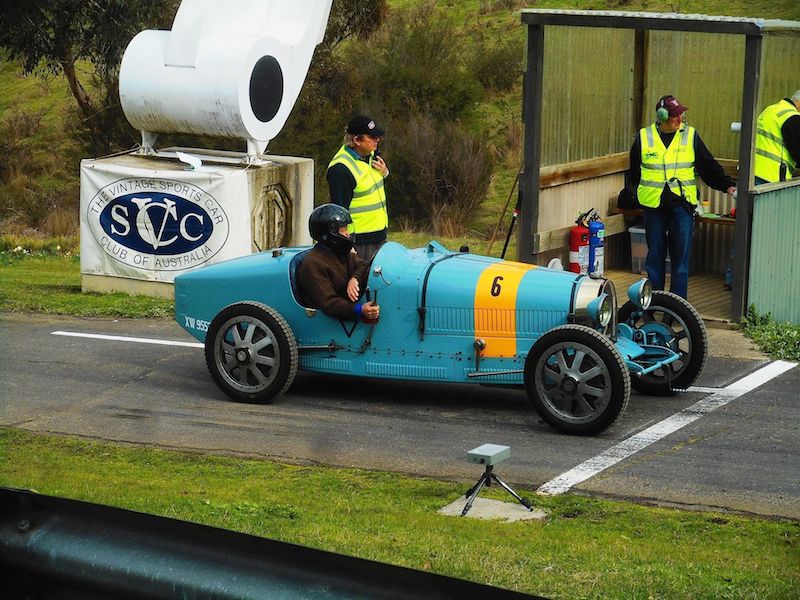
In 2014 – recognizing the distances covered – ‘4450’ benefited from a mechanical overhaul. New pistons and rings were fitted, the cylinder bores were honed and valves ground-in. In addition a new crown-wheel and pinion were fitted together with a new Dutton dry clutch. Examination of the crankshaft showed it required no attention.
Since that overhaul, the car has had less use, while still providing enjoyable motoring for the President of the Bugatti Club New Zealand on the biennial 2014 Great Australian Bugatti Rally. It has also been a regular winner of its class at the VSCC (Victoria) Rob Roy Hillclimb.
In every way this most remarkably well used, much-campaigned, thoroughly well-maintained and handsomely restored Bugatti Type 35 has a most impressive history. The ex-Glen Kidston, George Duller, Vivian Selby ‘4450’ is plainly an immensely useable, enormously eligible, Vintage Grand Prix car of proven long-distance touring and rally capability in addition to its on-track speed-event potential, and we recommend it to the market as being worthy of the closest possible consideration. Offered with Australian registration document, CAMS and FIVA papers.
—
This featured 1925 Bugatti Type 35 Grand Prix sold for €1,058,000 at the 2016 Bonhams Monaco sale, held May 13 at the Monte Carlo Fairmont Hotel in Monaco. We’re also pleased to report that the Bugatti was sold back to the original owners family, 91 years later!
[Source: Bonhams]


